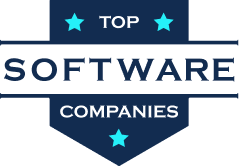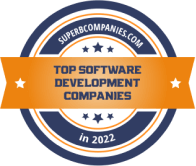A Comprehensive Guide to Securing Seed Funding for Your Startup
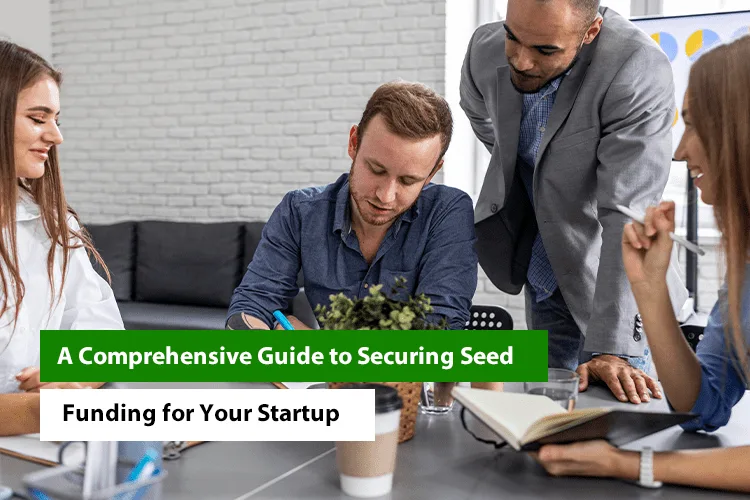
Have you ever wondered where seed money for such business endeavors as Uber, Airbnb, or Zoom comes from? What did they utilize to encourage individuals to invest in their ideas and risk in their dreams? The search for seed funding can be compared with the search for the needle in the desert for the intending businessman who has a wonderful idea but with no capital to fund it. Questions like; ‘Where do I find investors?’, ‘What to do for securing investors?’, ‘What makes a perfect pitch?’ are some of the things that put one to sleep.
Unknowing the fact that Startups in India have been getting relentless seed funding since 2019 the year 2021 is called the year of unicorns which produced more than 44 unicorn startups. In the long course of the year 2024, the government considered and recognized 127 thousand startups officially. The Indian startup ecosystem painted a picture of a positive revolution through innovation under the assumption of digitization.
This startup funding guide is designed to provide all the answers to these questions and much more. Regardless if you are getting ready to develop your initial pitch deck, looking for angel investors, creating an IT roadmap for your startup, or considering crowdfunding, we shall describe the course of action and key approaches to obtaining seed funding. Looking for tips on how to make your startup dream come true? Let’s dive in!
So, What is Seed Funding?
Seed funding also known as angel funding is the first type of startup finance that provides the funds required to turn the idea into an actual business. It is given the name “seed” funding because it provides the initial capital to support the growth of a business from its idea and conception stage into a full-blown and thriving business venture.
Seed funding financing is deployed on such functions as market analysis, creation of the first version of a product or a service, recruiting the initial team, or launch of the product or service. It is a critical round in the funding life cycle since it sets the ground for the next funding phases including Series A, B, and other funding rounds.
How to Secure Seed Funding?
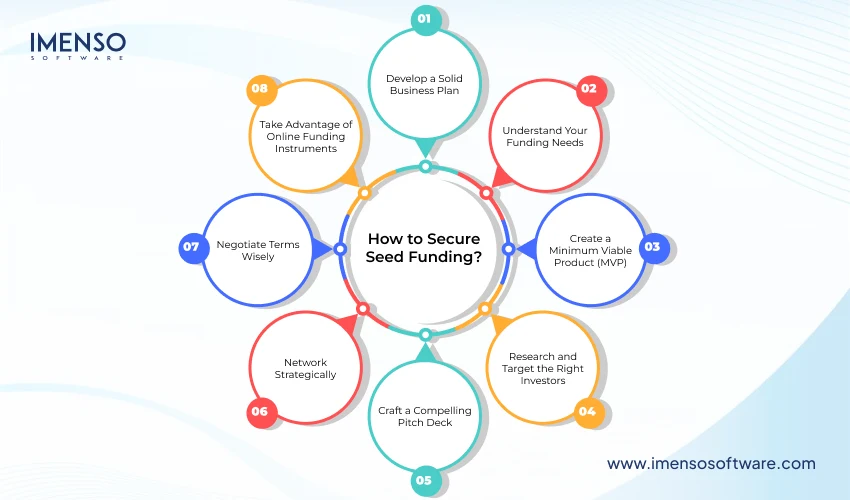
Fundraising for seed funding can be quite a hard task but can also be quite fruitful. You need to have a plan to scale your startup smartly in the technological world. Here is the detailed breakdown of each stage to enable you to achieve your purposes of sourcing for funds your startup.
Develop a Solid Business Plan
Having a good business plan is the starting point for preparing for funding. Businessmen are, in turn, eager to find out that you have a vision for your startup and how it will expand.
What to Include in Your Business Plan
Value Proposition: Describe the problem that your startup exists to solve as well as explain why your solution is better than others.
Market Analysis: Show a high level of knowledge of your audience and competitors.
Revenue Model: State how your business will make its revenue and how it will turn to Profit.
Scalability: They should show how the business can expand in the event that it covers more substantial markets or if the demand increases.
Financial Projections: Provide elaborate projected balance sheets for the next 3 – 5 years, accompanied by income statements and statements of cash flows.
Why It Matters: Such a plan proves to investors that the business idea has been well thought through and that the business has a well-outlined plan of success.
In case, you are wondering to choose a software development company for your startup, then our blog on how to select a software development company will help you.
Understand Your Funding Needs
This is very important to note down the seed funding you are going to need and how that capital will be employed.
Breakdown Your Funding Requirements:
- What amount of funding is required for the research & development of a product, advertising, recruiting human resources, and running a business?
- In what ways can this funding contribute to the accomplishment of significant benchmarks?
- What is the expected ROI for the investor out of this investment?
Why It Matters: Taking time to be clear about your funding needs creates credibility amongst investors because you are ready to do it right.
Create a Minimum Viable Product (MVP)
We know that people invest because they want to believe and need proof that their idea would work in real life. Coming up with a simple version of your product or service is very important.
Steps to Create an MVP
- Stay on the most critical features that help to solve the main issue.
- Take the product to a select group of users to get the results that will be essential in improving it.
- Continued refining for better solutions as informed by users.
Why It Matters: An MVP proves to investors that your idea is viable, and it can identify areas such as functionalities, in which users may have interest.
Research and Target the Right Investors
Unlike what one might think, identifying investors is about far more than the money, it is about identifying people who will support your vision.
How to Identify Investors
- Search for investors in your industry through AngelList, Crunchbase, or LinkedIn.
- Choose venture capitalists or angel partners who have invested in the same sector before.
- Look at their performance and what they stand for financially.
Why It Matters: Partnering with the right investors also means that in addition to funding, you also get to benefit from mentorship as well as other connections.
Craft a Compelling Pitch Deck
A pitch deck is your most valuable asset that you need to attract investor’s attention. It has to be simple, comprehensive, and attractive.
What to Include in Your Pitch Deck
- Introduction: A general description of your organization and goals and objectives.
- Problem: The problem you’re solving for your audience.
- Solution: How your product or service provides the solution.
- Market Opportunity: Number of potential consumers within your targeted segment and growth trends of the segment.
- Business Model: How you will make profits; the means through which income will be earned.
- Traction: The first key performance indicator or customer feedback.
- Team: Emphasize that you are a team of skilled and experienced professionals, who founded the company.
- Ask: Provide precise proposals as to how much money is required, and what you shall spend it on.
Why It Matters: An excellent pitch deck obtains attention, provides trust, and makes a lasting impression.
Network Strategically
Fundraising requires cultivating contacts with potential sources of seed funding and those people, who know that business needs.
How to Network Effectively
- Go to startup events, pitching competitions, and other business-related conventions.
- Learn how to become a member of startup incubators and accelerators to receive guidance and funds.
- Use your work contacts and request that they put you in contact with investors.
Why It Matters: Networking makes it possible to reach the relevant investor and provide the extra layer of legitimacy that may be required.
Negotiate Terms Wisely
Once investors show interest in a particular company, it will be advisable to engage in bargaining over the offer.
What to Focus On
- Valuation: Establish the most probable value of your new business.
- Equity: This means that you should decide on how much ownership you are willing to surrender.
- Terms: The area of entrepreneurial voting rights and board representation should be additionally elaborated within the context of the agreement.
- Exit Strategy: Explain how returns will be generated for investors on the investment that you want them to make.
Why It Matters: A balanced agreement makes both you and the investors happy and paves the way for a good working relationship.
Take Advantage of Online Funding Instruments
Using social networks, entrepreneurs can find another possibility to attract seed funding if there is a solid community base.
Popular Platforms
- Kickstarter and Indiegogo: Most suitable for consumer goods and innovative solutions.
- SeedInvest and WeFunder: Very suitable for equity crowdfunding.
- AngelList: A place to go find angel investors and venture capitalists to invest in your business.
Why It Matters: Crowdfunding helps to collect funds at the same time as the creation of a dedicated customer base.
Also Read:
Top 10 Cost Control Strategies for Startups
13 Successful Startup Pitch Tips for Pitching to Investors
How to Choose a Top Software Development Company for Startups
Comprehensive Seed Funding Strategies
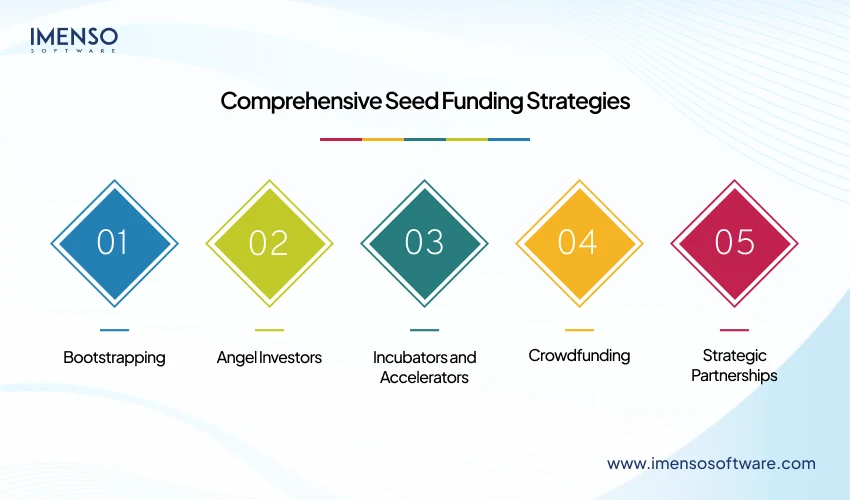
Below is the list of comprehensive seed funding strategies:
Bootstrapping
Some sources of funds for your startup could be your own money or revenue from other sources and this may attract investors who may believe in your project.
Angel Investors
Angel investors bring in capital at earlier phases of a company in return for stock. They can be more flexible than the conventional venture capital players.
Incubators and Accelerators
These programs not only provide funding but also support, materials, as well as connections to a range of affiliations.
Crowdfunding
Many crowdfunding sites enable you to get funds from different investors who contribute small amounts of money and at the same time create awareness. Show them the workflow efficiency of a startup, this will help you to gain their attention.
Strategic Partnerships
Consult with companies that are already in your industry and these would provide capital to support a particular project of common interest to the business.
Mistakes to Avoid When Seeking Seed Funding
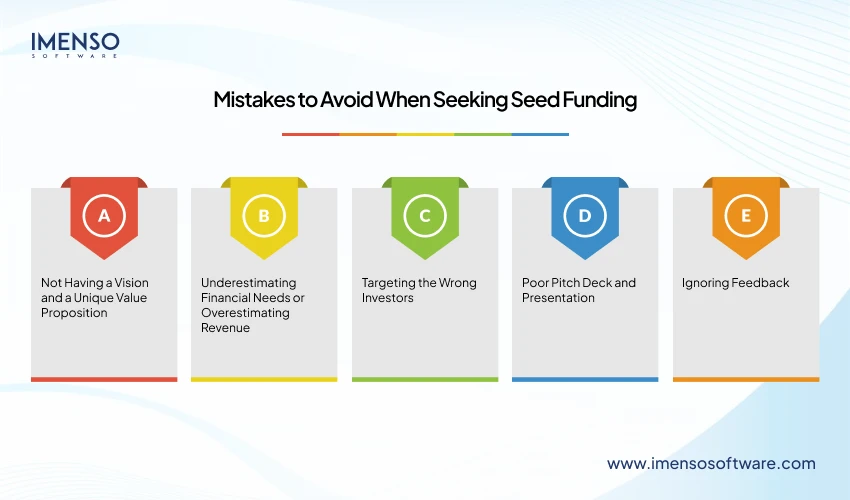
Raising seed funding is naturally a challenging task, and although there are numerous approaches to accomplish the task, there are a few pitfalls to avoid. Here are these pitfalls and let us see how to avoid them:
Not Having a Vision and a Unique Value Proposition
Potential shareholders and business angels expect a founder to demonstrate that a startup company has a mission and a clear position on how it serves a customer’s need.
- Mistake: Lack of clear business concept which leads to confusion among the investors.
- Why It Happens: Many founders attempt to compress a lot of concepts into the pitch or there are cases where the foundational problem being solved is not clearly defined.
- How to Avoid It: Avoid confusing your mission statement with your goals and objectives – the main issue that your startup is going to solve should be the focus of your mission. Do not use complex and many words to describe the value that you offer to your clients or that your business can bring in.
Underestimating Financial Needs or Overestimating Revenue
Miscalculations in seed capital can cause wrong expectations or inadequate amounts.
- Mistake: Submitting too low demands for the share they require or proposing unrealistic figures of revenues they expect to earn.
- Why It Happens: Sometimes, founders can avoid taking as much funding as possible to keep more equity or inflate the growth rate to attract investors.
- How to Avoid It: Provide basic financial ratios that include an accurate projection of funding needs and realistic revenues.
Targeting the Wrong Investors
Not every investor is suitable for your startup. Going to the wrong one wastes time and would not boost your standing with the clients.
- Mistake: Dealing with investors who lack knowledge of your business line or those who do not share your vision.
- Why It Happens: Insufficient surveys based on the investors’ profile, concerns, and goals.
- How to Avoid It: Select investors carefully. Concentrate on those who have invested in your industry or those who fund businesses in a similar phase to yours.
Poor Pitch Deck and Presentation
Your pitch deck is typically the first glimpse that investors will get of your startup. Their interest can be lost if the deck is not well designed or if the content is difficult to comprehend.
- Mistake: Designing a messy, unnecessarily overly complicated, or plain unattractive presentation.
- Why It Happens: Failure to convey sufficient data or failure to comprehend what the investors consider relevant.
- How to Avoid It: Ensure that your pitch deck is of not more than 12 slides, uncluttered with relevant contents, and closely reflects key areas of the pitch which include the problem, solution, target market, metrics, and growth story.
Ignoring Feedback
Rejection of funding is normal; however, not learning from it is counterproductive.
- Mistake: Ignoring helpful feedback or just not changing your presentation after receiving advice from investors.
- Why It Happens: It is possible for founders to get lost in their own thinking, have a loyalty to their idea, or feel hurt by critics.
- How to Avoid It: The gift of feedback should be embraced and accepted. Revise your argument and the way you do business in light of comments received.
Pro Seed Investment Tips:
- Be Persistent: Generally, seed funding implies disapproval of several proposals. Do not be discouraged; instead, engage in feedback to improve the implementation.
- Show Early Traction: Focus on several early adopters, business collaborations, or sales to demonstrate that your product is in demand.
- Communicate Transparently: Do not hide your problems and threats; investors expect the truth.
- Prepare for Due Diligence: Your financial statements and reports, market analysis, and legal documents will be under strong scrutiny by investors – ensure that you provide them with everything they need.
Final Conclusion: Making Your Vision a Reality
Getting seed funding is a very significant factor as it marks the first step in converting your start-up idea into reality. By following this startup funding guide, you lay the foundation for success. Do not forget that fundraising means looking for not only capital but also for partners who share your values and may contribute to your growth processes.
At Imenso Software we are aware of all the potential obstacles needed to transform great concepts into profitable ventures. Whether you require the latest technologies, assistance in the planning of your growth strategies, or an effective partner to turn your idea into reality, let us know.
We have been working with startups for years now and understand the model of creating only scalable solutions that meet the needs of investors and customers. Starting from the creation of MVPs to the sustenance of your growth journey, that’s what we offer.
Contact Imenso Software today to schedule a meeting and find out how our services can benefit your business. Also, you can read our reviews on Clutch!
FAQs
Where can I obtain seed capital for my business?
Identify potential investors like angels, VCs, and crowdfunding platforms that are relevant to your industry and stage of startup.
Which type of information should go into the pitch deck?
Explain how your product solves a specific problem and identify your target market. Include how you’ve gained users or momentum, revenue projections, and details about your team in a 10-12 slide pitch.
How much should I invest as an owner or founder in seed funding?
Normally the founders contribute 10–20% of the equity but this largely depends on valuation and funding.
Which documents do I have to provide to receive seed funding?
You will need a business plan, proforma income statement, balance sheet and cash flow, legal documents, and a PowerPoint presentation fit to due diligence for securing investors.
How long does it take to raise seed funding?
It can take as little as 3 up to 6 months depending on preparation and responses from investors.
Want more information about our services?
Similar Posts

Product Roadmap for Startups: Aligning With Your Business Strategy
“Whenever you see a successful business, someone once made a courageous decision.” Peter Drucker Of course, the courageous decision can be starting a business. But it can also be creating a product roadmap. An effective roadmap presents a clear path forward, communicating how an organization’s short-term efforts align with its longer-term objectives. When done right, […]...
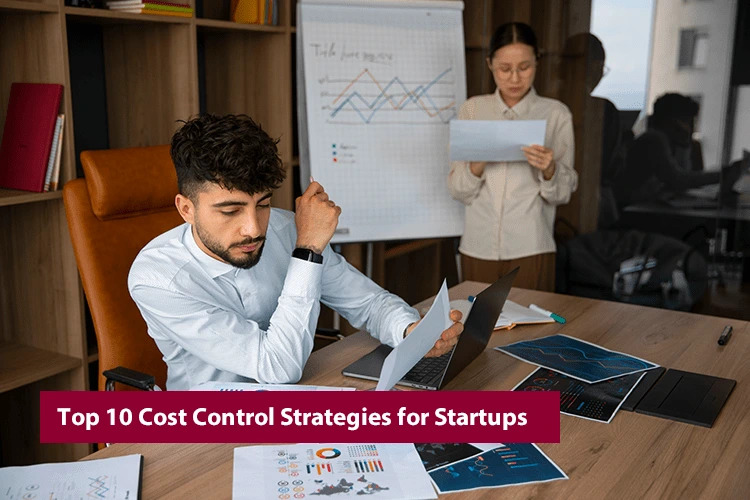
Top 10 Cost Control Strategies for Startups
Are you struggling to manage your startup’s finances while still focusing on growth? Cost control is an essential factor in new business since it differentiates between success and failure. According to the study, funding emerges as the leading cause of startup failure among new businesses, with a figure of 28.2%. Nevertheless, this statistic shows the […]...

How to Build a Scalable Customer Acquisition Plan
In 2012, Dropbox had a tough nut to crack: how to increase users without spending too much. They did it by introducing an ingenious referral program where users got additional free storage space for inviting friends. This helped them increase their users from 100,000 to 4 million in a remarkable time frame of 15 months. […]...


